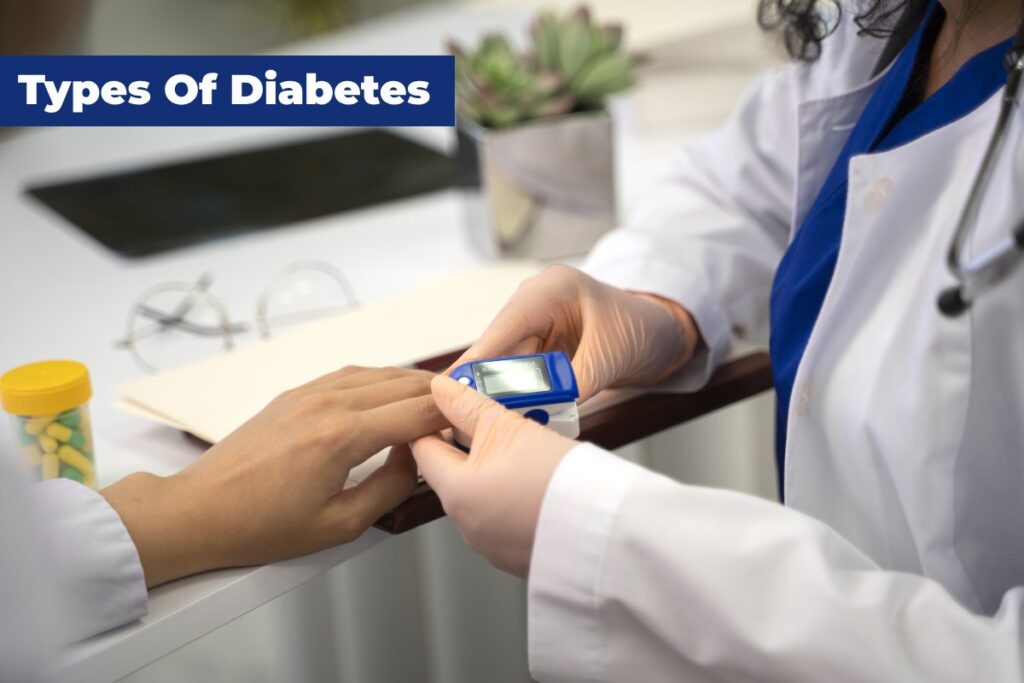
<a href="https://www.freepik.com/free-photo/doctor-checking-patient-side-view_32338380.htm#fromView=search&page=1&position=21&uuid=51faedbe-f305-4942-9358-5947b3c165a3">Image by freepik</a>
Types Of Diabetes
There are several different types of diabetes, and each carries its own potential complications.
Diabetes, scientifically known as diabetes mellitus, is a complex condition with many different forms.
It’s a serious health condition characterized by high blood sugar levels, which can occur due to insufficient insulin production, or the ineffectiveness of insulin produced.
Alternatively, it may arise when the body is unable to produce any insulin at all.
The two most common types of diabetes are known as type 1 and type 2.
In addition to the well-known types of diabetes, other less common but important types exist. These include various forms of monogenic diabetes, diabetes related to cystic fibrosis, as well as diabetes caused by rare syndromes.
Additionally, certain medications like steroids and antipsychotics, hormonal imbalances, and surgical procedures can also lead to the development of these less common types.
Unfortunately, misdiagnosis is common among individuals with these types, which can delay proper treatment.
What are the different types of diabetes?
Diabetes manifests in different forms, each with its own set of potential complications. In this section, we will explore the different types of diabetes and their associated complications.
The three main types of diabetes are: type 1 diabetes, type 2 diabetes, and gestational diabetes. Let’s explore each type and the potential complications associated with them.
Type 1 Diabetes
Type 1 diabetes is characterized by the body’s inability to produce insulin due to the destruction of insulin-producing beta cells in the pancreas. Complications that can arise from type 1 diabetes include:
- Diabetic ketoacidosis (DKA): This is a severe condition where the body breaks down fat for energy instead of glucose, leading to a dangerous buildup of ketones in the blood.
- Hypoglycemia: This happens when low blood sugar levels that can cause symptoms such as dizziness, confusion, and, in severe cases, loss of consciousness.
- Long-term complications: These may include cardiovascular disease, kidney disease (diabetic nephropathy), nerve damage (diabetic neuropathy), eye damage (diabetic retinopathy), and foot problems.
Type 2 Diabetes
Type 2 diabetes is characterized by insulin resistance, where the body becomes less responsive to insulin or doesn’t use it effectively. Complications associated with type 2 diabetes include:
- Cardiovascular complications: Individuals with type 2 diabetes are at a higher risk of developing heart disease, heart attacks, and strokes.
- High blood pressure: Diabetes can lead to elevated blood pressure levels, increasing the risk of heart and kidney problems.
- Kidney disease: Diabetes is a leading cause of kidney failure, known as diabetic nephropathy.
- Eye complications: Type 2 diabetes can cause damage to the blood vessels in the retina, leading to diabetic retinopathy and potential vision loss.
- Nerve damage: Diabetic neuropathy can result in numbness, tingling, or pain in the hands, feet, or legs.
- Foot complications: Diabetes-related nerve damage and poor blood circulation can lead to foot ulcers, infections, and even amputations if not properly managed.
Gestational Diabetes
Gestational diabetes occurs during pregnancy and usually resolves after childbirth. However, it can pose risks to both the mother and the baby. Complications may include:
- Increased risk for cesarean delivery: Women with gestational diabetes may have a higher likelihood of delivering via cesarean section.
- Macrosomia: The baby may grow larger than average, increasing the risk of birth complications.
- Low blood sugar in newborns: The baby may experience low blood sugar levels shortly after birth.
- Type 2 diabetes risk: Women who have had gestational diabetes are at a higher risk of developing type 2 diabetes later in life.
Other Types of Diabetes
For 1% to 9% of people with diabetes, other underlying conditions may be the culprit. These can include pancreatic diseases, surgeries, medications, or infections. In such cases, your doctor will likely monitor your blood sugar levels closely.
Here are some of the less common types of diabetes:
- Type 3c diabetes
- Neonatal diabetes
- Wolfram Syndrome
- Steroid-induced diabetes
- Cystic fibrosis, diabetes
- Latent Autoimmune Diabetes in Adults (LADA)
- Maturity-onset diabetes of the young (MODY)
Type 3c Diabetes
Type 3c diabetes develops when another disease damages the pancreas.
This can be caused by conditions like pancreatic cancer, pancreatitis, cystic fibrosis, or hemochromatosis.
Surgery to remove part or all of the pancreas (pancreatectomy) can also lead to type 3c diabetes.
People with this type often experience a deficiency in digestive enzymes needed for proper digestion.
Management typically involves oral medications and/or insulin.
Neonatal Diabetes
Neonatal diabetes is diagnosed in infants under six months old. Insulin helps our body’s cells use energy from food.
Infants with this condition don’t produce enough insulin, leading to high blood sugar.
Unlike type 1 diabetes, neonatal diabetes isn’t an autoimmune disease where the body attacks insulin-producing cells.
It can also affect fetal growth, resulting in newborns being smaller than expected (intrauterine growth restriction).
Wolfram Syndrome
Wolfram syndrome, also known as DIDMOAD syndrome, is a rare sickness that someone can be born with.
It’s named DIDMOAD because it can cause diabetes insipidus, diabetes mellitus, optic atrophy, and deafness.
This sickness can harm the brain and other parts of the body.
Usually, kids start to show signs of this sickness, and it continues as they grow up.
The first signs often include diabetes and problems seeing before they turn 15.
Over time, it can harm the brain so much that it can lead to death at a young age.
Steroid-Induced Diabetes
Steroid-induced diabetes is when someone’s blood sugar levels go up because they’re taking steroids.
This can happen to people who have diabetes and to people who don’t.
Some people who take steroids might get diabetes because of it. This is more common in people who are more likely to get type 2 diabetes.
Steroid-induced diabetes is similar to type 2 diabetes because in both cases, the body’s cells don’t respond to insulin like they should.
This is different from type 1 diabetes, where the pancreas doesn’t make insulin.
Cystic Fibrosis Diabetes
Cystic fibrosis diabetes is the most common type of diabetes in people with cystic fibrosis.
It’s a bit like type 1 and type 2 diabetes, but it’s actually a different kind of diabetes.
Cystic fibrosis diabetes (CFD) often happens in people with cystic fibrosis, usually when they’re between 18 and 21 years old. More people get it as they get older.
About half of people with cystic fibrosis get diabetes by the time they’re 30, and up to 90% of adults with cystic fibrosis have trouble controlling their sugar levels by the time they’re 40.
Latent Autoimmune Diabetes in Adults (LADA)
LADA is a form of autoimmune diabetes that typically appears in adulthood and progresses gradually.
Like type 1 diabetes, LADA results from the immune system attacking pancreatic cells, hindering insulin production.
It shares characteristics of both type 1 and type 2 diabetes, leading some to call it “type 1.5” due to its overlapping features.
Unlike type 1, LADA develops slowly, and individuals may not need immediate insulin treatment, especially in the early stages.
LADA isn’t yet a distinct diabetes classification, but research is ongoing to identify its unique features.
Maturity-Onset Diabetes of the Young (MODY)
MODY is a rare form of diabetes caused by a mutation in a single gene.
This means it’s inherited from a parent, with a 50% chance of passing the mutation (and risk of MODY) to their child.
Unlike type 1 and type 2 diabetes, MODY typically develops before age 25, regardless of weight, lifestyle, or ethnicity.
Treatment with sulfonylurea medications can effectively manage blood sugar levels in individuals with MODY.
Causes of Different Types of Diabetes:
- Type 1 diabetes: Type 1 diabetes is an autoimmune condition where the immune system attacks insulin-producing cells in the pancreas. The exact cause is unknown but likely involves genetics and the environment. Lifestyle factors are not considered significant contributors.
- Type 2 diabetes: Type 2 diabetes develops when the body’s cells become resistant to insulin, leading to high blood sugar. The pancreas initially increases insulin production but eventually can’t keep up, leading to high blood sugar. The cause is complex and likely involves a combination of genetics, lifestyle (including physical activity and weight), and other health factors.
- Gestational Diabetes: Gestational diabetes is caused by hormones produced during pregnancy that interfere with insulin’s action. It’s more common in women with prediabetes or a family history of diabetes. About half of women with gestational diabetes are at higher risk of developing type 2 diabetes later in life.
These are the general causes associated with different types of diabetes.
Remember, consulting a healthcare professional is crucial for a comprehensive evaluation and understanding of the specific factors contributing to your individual case.
How Are Different Types of Diabetes Treated?
The treatment for different types of diabetes varies, and it’s important to work closely with your doctor to manage it effectively.
The primary goal is to maintain your blood glucose levels within a specific range, called your blood glucose goals.
These goals are determined by your doctor and may vary depending on your type of diabetes, age, and any existing complications.
For example, blood glucose goals for gestational diabetes are typically lower than for other types.
Physical activity and diet play crucial roles in diabetes management.
Your doctor will recommend an appropriate amount of aerobic exercise per week, and you’ll need to follow a healthy diet plan.
Additionally, regular monitoring of blood pressure and cholesterol levels is essential for overall health.
Treatment for Type 1 Diabetes:
Since the damage to the pancreas in type 1 diabetes is permanent, individuals with this condition rely on insulin for survival.
Several types of insulin exist, each with different starting points (onset times), peak effectiveness periods, and lasting durations.
Your doctor will determine the most suitable type and dosage of insulin for you.
Insulin is typically injected just beneath the skin.
Your doctor will demonstrate the correct injection technique and teach you how to rotate injection sites to prevent irritation.
Another option is an insulin pump, an external device that can be programmed to deliver specific doses of insulin throughout the day.
Continuous blood glucose monitors are now available, providing real-time monitoring of blood sugar levels throughout the day.
However, it’s important to discuss the ideal blood sugar monitoring frequency with your doctor for optimal management.
In some cases, medications may also be prescribed to manage complications like high blood pressure, cholesterol, or other related conditions.
Treatment for Type 2 Diabetes:
Type 2 diabetes can often be managed and, in some cases, even put into remission through lifestyle modifications like diet and exercise.
Medications are also available to help regulate blood sugar levels.
The first-line medication for type 2 diabetes is typically metformin (Glumetza, Glucophage, Fortamet, and Riomet), which works by reducing glucose production in the liver.
If metformin is ineffective or insufficient, your doctor may prescribe medications from other classes, such as sulfonylureas, DPP-4 inhibitors, or GLP-1 receptor agonists.
These medications work in different ways to regulate blood sugar levels.
Regular monitoring of blood sugar levels is essential to managing type 2 diabetes. Medications may also be prescribed to control blood pressure and cholesterol levels.
Remember, it’s crucial to follow your doctor’s guidance and communicate with them regularly to ensure effective management of your diabetes.
This includes discussing your treatment plan, blood sugar goals, and any questions or concerns you may have.
How to Determine the Types of Diabetes in a Patient
In certain situations, determining the specific type of diabetes an individual has can be challenging.
If your doctor is uncertain about your diabetes type, they may conduct one or more tests to assist in the diagnosis process.
These tests help your doctor confirm the type of diabetes and determine the most appropriate treatment plan.
The type of diabetes you have can typically be determined through a combination of factors, including your medical history, physical examination, specific blood tests, and the age of onset.
Here are some common methods used to differentiate between the types of diabetes:
1. Medical History
Your healthcare provider will ask about your symptoms, family history of diabetes, and any other relevant medical conditions.
They will obtain a comprehensive medical history, including a family history of diabetes, previous diagnoses, and any related medical conditions.
2. Symptoms and Onset
They will evaluate the patient’s symptoms and the timeline of their onset.
Type 1 diabetes often presents with rapid symptom development, such as frequent urination, increased thirst, and unexplained weight loss.
On the other hand, type 2 diabetes may have a more gradual progression, and symptoms may be mild or even absent initially.
Additionally, the age of diabetes onset is considered.
Type 1 diabetes typically develops in childhood or young adulthood, while type 2 diabetes can occur at any age but is more common in adults.
3. Physical Examination
A thorough physical examination will be conducted, including measuring blood pressure, assessing body weight, and looking for signs of insulin resistance or metabolic syndrome.
A physical examination may reveal signs associated with certain types of diabetes, such as obesity or signs of insulin resistance in Type 2 diabetes or symptoms of autoimmune conditions in Type 1 diabetes.
4. Blood Tests:
Blood tests play a crucial role in diagnosing diabetes and differentiating between types. Here are some common tests used:
- Fasting Blood Sugar (FBS) Test: Measures your blood sugar level after not eating or drinking anything (except water) for at least eight hours. Results above the normal range may indicate diabetes.
- Oral Glucose Tolerance Test (OGTT): This test measures your blood sugar levels both after fasting and again two hours after consuming a sugary drink. It helps assess your body’s ability to process glucose and can be used to differentiate between types of diabetes.
- Hemoglobin A1c (HbA1c) Test: This test measures the percentage of red blood cells coated with sugar over the past 2–3 months. Elevated HbA1c levels are a strong indicator of diabetes, but other tests may be needed for a definitive classification.
- Autoantibody Tests: In some cases, your doctor may recommend autoantibody tests, such as testing for islet cell antibodies or glutamic acid decarboxylase (GAD) antibodies. These tests detect the presence of antibodies that attack insulin-producing cells. Positive results can be indicative of type 1 diabetes, where the body’s immune system destroys these cells.
5. C-peptide Test
This test measures the level of C-peptide in the blood, an indicator of insulin production, to help differentiate between type 1 and type 2 diabetes.
Type 1 diabetes is associated with low or undetectable levels of C-peptide, while Type 2 diabetes typically involves normal or high levels.
6. Urine Tests
While not a diagnostic tool for diabetes, urine tests may be conducted to check for ketones, which are produced when the body breaks down fat for energy due to a lack of available insulin.
The presence of ketones can indicate uncontrolled Type 1 diabetes or diabetic ketoacidosis.
7. Other Specialized Tests
Depending on the clinical presentation, additional tests may be necessary to rule out other conditions or complications associated with diabetes.
This may include genetic testing for specific types of diabetes or an assessment for gestational diabetes in pregnant women.
Note
Based on the results of these tests and evaluations, your healthcare provider will be able to determine the type of diabetes you have and develop an appropriate treatment plan tailored to your needs.
It is crucial to consult with a healthcare professional for an accurate diagnosis and to determine the most appropriate treatment plan based on the specific type of diabetes diagnosed.
Self-diagnosis is not recommended, and consulting a doctor is essential for the proper management of diabetes.
Final Note
Diabetes can manifest in various forms, each with varying prevalence rates.
Type 2 diabetes is the most common, affecting roughly 90–95% of people with diabetes.
It often develops from a condition called pre-diabetes. Type 1 diabetes, constituting about 5–10% of cases, is more frequently diagnosed in children and young adults.
Gestational diabetes, a temporary form affecting 2-10% of pregnancies, can develop during pregnancy.
It’s important for individuals with any types of diabetes to work closely with their healthcare team to manage their condition and minimize the risk of complications.
Regular monitoring, medication, lifestyle modifications, and timely medical interventions can help mitigate the impact of these complications.
DISCLAIMER:
The information provided in this article is meant for general informational purposes only and does not take into account your specific circumstances. It should not be considered as a replacement for professional assistance or advice. You should not solely rely on the information presented in this article when making decisions. Any action taken based on the information in this article is done so at your own risk and responsibility.
Sharing valuable content is a great way to help others! If you found this post about “Types of Diabetes” helpful or think it might be useful to others, please feel free to share it. You never know who might need this information. Thank you!







